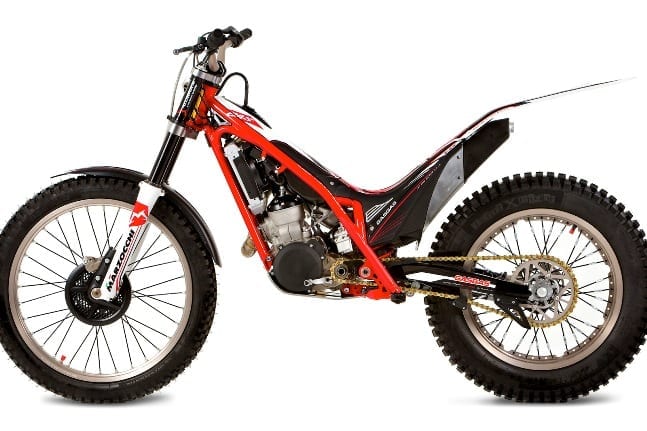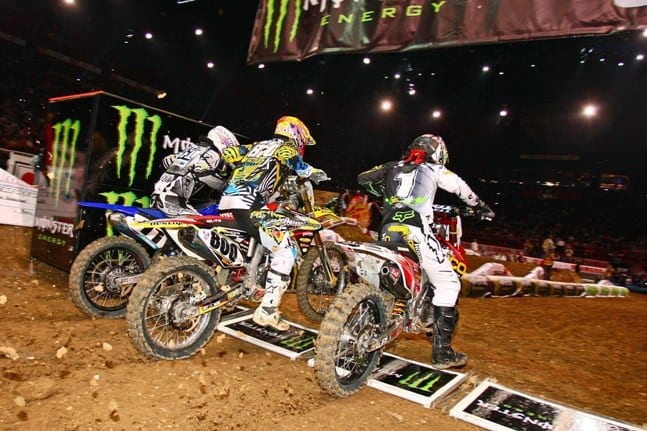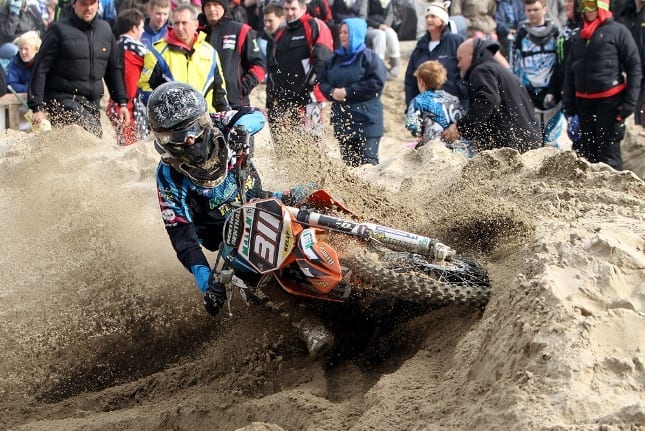Gas and flair
By TMX Archives on 4th Nov 11

To say that trials is pretty much a specialised sport is to drastically understate the case. Trials riders are in the main very clued-up on their sport and know whats what which is why carrying out bike tests is often no easy matter.
Most riders know exactly what they think about certain marques and models and sometimes all we do is confirm what they already know. But it never hurts to get back to basics and start the evaluation from scratch.
Every trials rider knows pretty much exactly what a Gas Gas is and what it does. Yet we would argue that a Gas Gas from even three years ago is very different to what you get now – for several reasons.
The range got a comprehensive redesign last year, which was a major step forward and the Gerona factory has made some pretty big strides in the quality department even in the last six-to-12 months.
Some of the most recent are a direct result of Dougie Lampkin's involvement.
For 2011 the Gas Gas chassis was completely redesigned, and while the basic, simple, steel-tube perimeter frame remains intact, the rear section was replaced with a practical and visually pleasing tubular arch structure making up the rear shock mount.
This in turn allowed a total rethink of the exhaust and airbox design, with the end result effectively removing all previous criticism of either function.
It was the biggest and best redesign by GG since the introduction of the PRO series.
The engine and six-speed box, still one of the smallest, most compact units around, sits neatly in the chassis with the latest Marzocchi forks up front and the expected aluminium swinging-arm at the rear, controlled by a new Sachs rear shock, fitted with a new design spring and new linkage ratio.
The white painted forks are a contrast to the previous black version and they allegedly offer less stiction.
One change which is making its way into production is new brakes – courtesy of Italian manufacturer Formula. These look very trick and show obvious mountain-bike influence sporting short, adjustable, folding levers.
But are they actually any better?
That is for tester WOODY HOLE to say as he got to give all four 2012 Gas Gas PRO models – 125/ 250/ 280 and 300 – a gallop at the famous Hawks Nest venue near Buxton.
THE 125 Gasser has always been right up there at the head of 125 trialsdevelopment, pushing the boundaries – usually the rev boundaries because nothing revs like a Gas Gas 125.
But there's much more to the smallest capacity full-size Gas Gas than just revs.
When there's a multi-test we always try and ride in the perceptive order ofperformance in order to get the mostobjective feel of the bikes.
It seems daft to ride the most powerful first as the perspective would then get skewed.
But as 125s get better and better it is no longer strictly necessary. As we have said on numerous occasions, 125s have come on so much in just a couple of years you can almost stop calling them 125s.
It is a hugely important market because that is what Youths are restricted to, but in reality the 125 Gas Gas is just a trials bike that happens to be 125cc capacity.
The performance is truly stunning, given the capacity.
We know Gas Gas models have a reputation for giving out-and-out top-end, for revving on when others have given their all.
And they still do, but there's now much more to the GG125 than just being a revbox.
There is now good bottom-end and middle range as well.
I weigh considerably more than your average youth trials rider and I could ride sections in not only the first three gears but could actually ride up the steep hill (if not over the rocks) in fourth as well. Impressive stuff.
As you'd expect the 125 feels so light you hardly know you are riding a motorbike (like with all 125s, it is an amazing illusion).
This model, like the 250 and 300, was absolutely brand new, hadn't turned a wheel and compared to the 280, which had seen some use, it did feel a little stiff to begin with.
But with just what we did on the day you could feel it softening-up in the suspension and the motor freeing the more we rode it. This is how it should be.
It is a dream to ride for youths, with the free-revving engine, feather-light controls and the quick handling chassis making riding so easy.
The riding position is very natural and the rear suspension virtually does the job for you. Just ride into things and the Gasser will help you all the way.
I can't say that I really noticed the new shock or linkage making an obvious
difference but these days there are no huge strides forward but small steps each year does make a difference.
There are more and more adults – older or lighter individuals – having a look at the 125 option because you can just ride it forever without getting tired. And it is so capable.
If you haven't ridden a modern 125 before you should blag a test ride. You'll be amazed.
2012 model Gas Gas TXT 125 PRO/ 250 PRO/ 280 PRO/ 300 PRO
ENGINE
Type: Liquid-cooled, single-cylinder two-stroke with direct crankcase reed-valve induction
Capacity: 124.8cc/ 247.7cc/ 272.2cc/ 294.1cc
Bore x Stroke: 54 x 54.5/ 72.5 x 60/ 76 x 60/ 79 x 60mm
Induction: 26mm Dell'Orto carburettor
Ignition: CDI Digital Magnetic Flywheel
Gear Selector: Gas Gas patented coaxial selector
Clutch: 1/3 diaphragm discs with adjustable hydraulic actuation (Gas Gas patented)
Gear Box: Six-speed with GG 4/6 technology
Transmission: Roller chain
Lubrication: 2% Fuel/ oil pre-mix
FRAME
Type: Chrom-Molybdenum tubular design with aluminium swinging arm
SUSPENSION
Front: Marzocchi 40mm conventional telehydraulic aluminium fork with adjustable compression and rebound damping. 177mm travel
Rear: Sachs hydraulic mono-shock with adjustable rebound and spring preload. 164mm travel
BRAKES
Front: 185mm floating disc with four-piston calliper
Rear: 150mm disc with two-piston calliper
WHEELS
Front: Light aluminium rim with 2.75 x 21” Michelin tyre
Rear: Light aluminium rim with 4.00 x 18” tubeless Michelin tyre
ANCILLARIES
Engine guard: Manufactured in ergal
Kick Start: Forged aluminium
Brake Pedal: Forged aluminium with retractable tip
Exhaust Pipe: S3 titanium header pipe, aluminium middle-box and repackable silencer
DIMENSIONS
Overall length: 2,045mm
Width: 825mm
Height: 1.130mm
Wheelbase: 1.340mm
Seat Height: 660mm
Fuel Capacity: 2.5 litres
Dry Weight: 67kg
FOR FULL REPORT AND PICTURES SEE T+MX NOVEMBER 4


